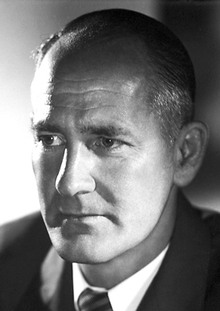George Wells Beadle
| George Beadle | |
|---|---|
 |
|
| Born | George Wells Beadle October 22, 1903 Wahoo, Nebraska, United States |
| Died | June 9, 1989 (aged 85) Chicago, Illinois, United States |
| Fields | Genetics |
| Institutions |
California Institute of Technology University of Chicago Harvard University Stanford University |
| Alma mater |
University of Nebraska Cornell University |
| Thesis | Genetical and Cytological Studies of Mendelian Asynapsis in Zea mays (1930) |
| Doctoral advisor | Franklin D. Keim |
| Known for |
One gene-one enzyme hypothesis Gene regulation of biochemical events within cells |
| Notable awards | Albert Lasker Award for Basic Medical Research (1950) Nobel Prize in Physiology or Medicine (1958) Thomas Hunt Morgan Medal (1984) |
George Wells Beadle (October 22, 1903 – June 9, 1989) was an American scientist in the field of genetics, and Nobel Prize in Physiology or Medicine Nobel laureate who with Edward Tatum discovered the role of genes in regulating biochemical events within cells in 1958.
Beadle and Tatum's key experiments involved exposing the bread mold Neurospora crassa to x-rays, causing mutations. In a series of experiments, they showed that these mutations caused changes in specific enzymes involved in metabolic pathways. These experiments led them to propose a direct link between genes and enzymatic reactions, known as the One gene-one enzyme hypothesis.
George Wells Beadle was born in Wahoo, Nebraska. He was the son of Chauncey Elmer Beadle and Hattie Albro, who owned and operated a 40-acre (160,000 m2) farm nearby. George was educated at the Wahoo High School and might himself have become a farmer if one of his teachers at school had not directed his mind towards science and persuaded him to go to the College of Agriculture in Lincoln, Nebraska. In 1926 he took his Bachelor of Science degree at the University of Nebraska and subsequently worked for a year with Professor F.D. Keim, who was studying hybrid wheat. In 1927 he took his Master of Science degree, and Professor Keim secured for him a post as Teaching Assistant at Cornell University, where he worked, until 1931, with Professors R.A. Emerson and L.W. Sharp on Mendelian asynapsis in Zea mays. For this work he obtained, in 1931, his Doctor of Philosophy degree.
...
Wikipedia
